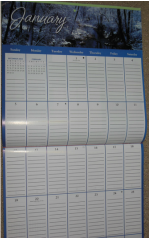
I have always hated that term New Year’s resolution. Resolutions
were meant to be made but never really meant to be kept. Just because you don’t want to make a New Year’s resolution doesn’t mean you can’t make plans. I am big on making plans and planning everything well ahead of time. Making plans is setting goals, and goals are good.
Last week I bought a calendar that has lots of blank spaces for each day. I’m in the process of filling it up hoping to keep myself organized and help myself to plan ahead for a new year of writing. This is my way of setting goals for myself. This is a way I can spread out projects and make sure that each one of them gets done by specific dates; some of the states are very important in my plan making. For example, I know I went to promote the first anniversary of my novel in February. I have begun making plans for that in January so that when February rolls around I’m all set.
By planning ahead I know when I need to send in articles and stories for publications for next Christmas. (Yes, I am already planning for next Christmas!) For several years I have been working on a book geared toward homeschoolers. I want to have this finished by July so I can start promoting it and selling it for the new school year.
So what are your plans for the future? Do you have a novel you want to finish? Do what to send out more articles and stories and you did last year? Do you have a book you want to publish?
Share your plans with me. Share your plans with other writers helps keep you accountable. If you share one of your goals with me in the comments I promise to check that once in a while to make sure that you are still working and that you are succeeding in meeting your goals. If you need help
finding a publisher for your book, I can help you with that as well.
So…what are your plans?
were meant to be made but never really meant to be kept. Just because you don’t want to make a New Year’s resolution doesn’t mean you can’t make plans. I am big on making plans and planning everything well ahead of time. Making plans is setting goals, and goals are good.
Last week I bought a calendar that has lots of blank spaces for each day. I’m in the process of filling it up hoping to keep myself organized and help myself to plan ahead for a new year of writing. This is my way of setting goals for myself. This is a way I can spread out projects and make sure that each one of them gets done by specific dates; some of the states are very important in my plan making. For example, I know I went to promote the first anniversary of my novel in February. I have begun making plans for that in January so that when February rolls around I’m all set.
By planning ahead I know when I need to send in articles and stories for publications for next Christmas. (Yes, I am already planning for next Christmas!) For several years I have been working on a book geared toward homeschoolers. I want to have this finished by July so I can start promoting it and selling it for the new school year.
So what are your plans for the future? Do you have a novel you want to finish? Do what to send out more articles and stories and you did last year? Do you have a book you want to publish?
Share your plans with me. Share your plans with other writers helps keep you accountable. If you share one of your goals with me in the comments I promise to check that once in a while to make sure that you are still working and that you are succeeding in meeting your goals. If you need help
finding a publisher for your book, I can help you with that as well.
So…what are your plans?
 RSS Feed
RSS Feed
